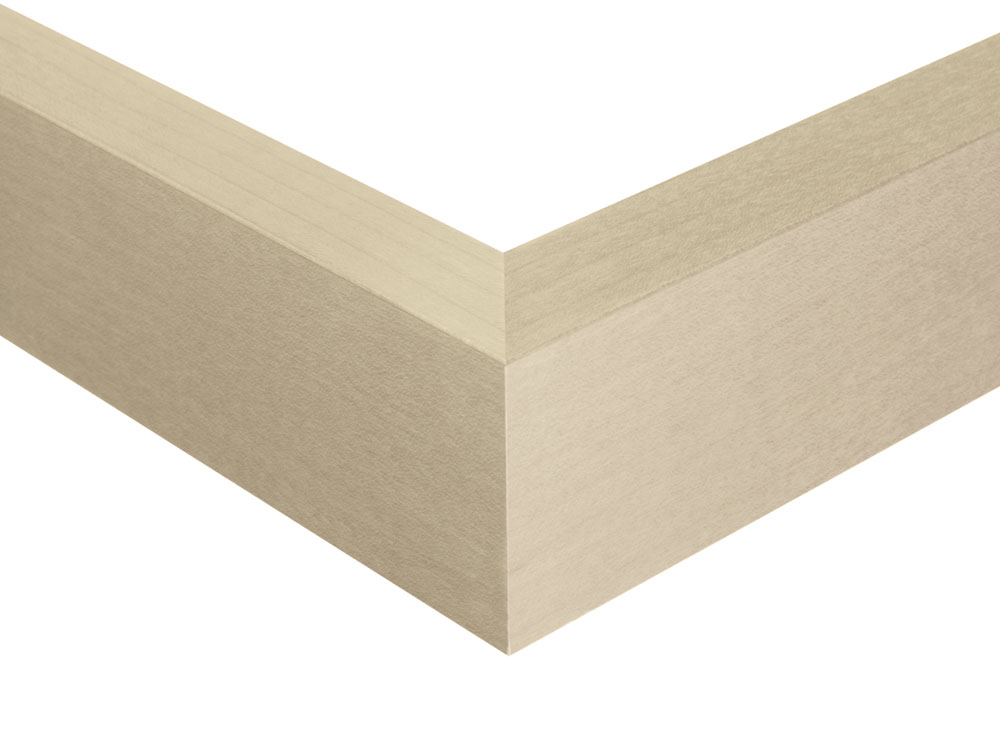THE WAY TO THE PERFECT FRAME
This is how you design your ideal picture frame
A picture frame fulfills many tasks. It supports the effect of the picture and should help it to unfold its full effect. However, the picture itself is always in the foreground and its meaning should only be emphasized. A suitable picture frame can also be described as the perfect stage for your picture. The picture and frame merge into a unity and a symbiotic relationship is created. The right frame supports the effect of your picture optimally by choosing the right colour, material and size.
But it's not just the appearance that plays a major role; the right frame should also fully meet conservational requirements. Fingerprints, dust, ultraviolet light, humidity, theft or awkward handling endanger the object, therefore the frame takes on the task of protecting it from negative influences in the best possible way and thus preserving its cultural and financial value.
Finding the right frame is often not easy, because many factors play a decisive role. To make your decision a little easier, we have put together a way for you to orient yourself - the goal: the perfect frame.
Contents
1. The type of presentation
2. Design tips
3. The passepartout
4. The size
5. The place
6. The material
7. The colour of the frame
7.1. The brightness
7.2. The paper
7.3. The colour of the motif
7.4. The colour of the distance strips
8. Profile/strip cross section
9. The glass
10. The insertion depth
At first the type of image presentation must be determined. The possibilities are as numerous as the pictures themselves. Just as versatile are the mounting options for the pictures in the picture frame. The desire to present one's own picture, the material of the object and one's own demand for value retention require different craftsmanship.
The following types of presentation are possible:




Flat
The picture lies completely in the picture frame. Usually, the Classic magnetic frame is used, or alternatively, the Conservo magnetic frame for higher conservation requirements. To achieve a special depth effect, select the Distance magnetic frame.
With passepartout
The picture is smaller than the frame and is surrounded by a passepartout and slightly pressed on. Usually the Classic magnetic frame is used here. For a special conservation requirement, select the Conservo magnetic frame. The special depth effect is achieved with the Distance magnetic frame.
Free floating
The picture is smaller than the frame and floats, either in a passepartout cut-out or in a distance frame, invisibly held in the frame. Here the distance magnetic frame is used. The depth of the distance depends on the thickness of the object. The highest point of the paper should be at least 3 millimeters away from the glass.
Free floating on a pedestal
The picture is smaller than the frame and floats with an additional distance to the rear wall in a distance frame. Here the distance magnetic frame is used. The depth of the distance depends on the thickness of the object. The highest point of the paper should be at least 3 millimeters away from the glass.
More detailed tips for mounting the pictures in the picture frame can be found in our know-how area mounting.
The main task of a picture frame is to support the picture and fully emphasize its effect. Therefore it makes more sense to adapt the frame to the colour of the picture than to the interior design and architecture. The picture frame should be selected in material, colour and size to match the picture, so that the picture is not undermined by the frame.
If only a single picture is hanging on a wall, the frame can be perfectly matched to the subject. However, when a series is framed, the frame must fit all motifs. In a continuous series, it is usually easy because the motifs are similar. In wall designs where different motifs are associated, the frame must harmonise with all the pictures. Here, a subtle frame is recommended, which as a constant provides optical calm. Classic colours are a good choice.
If framed pictures are hanging on a wall and need to be supplemented, you have to make sure that the new picture frame fits in. If there is already a colorful mixture, one is not restricted. If there are otherwise only frames of one type, a break can be noticeable in the positive, as well as in the negative.

Framing with a passepartout opens up many design possibilities for skilfully staging a picture and underlining its effect, because the passepartout directs the eye directly to the picture. This type of framing is one of the most classic types of framing. The white border of the passepartout gives the picture a unique stage and the special depth effect enhances it very well. The picture is smaller than the picture frame and the glass does not rest directly on the object, which is important for the protection of the work.


How wide a passepartout should be is ultimately a matter of taste. It usually looks harmonious when the width of the passepartout edge is about 10-12% of the size of the longer side. Small pictures can be optically enlarged by large passepartout frames, so that they do not get lost on the wall. The colour of the passepartout should be a shade darker or more yellow than the paper of the picture. So the picture looks more white, more fresh and new.

It is best to try it out for yourself and design your passepartout in our configurator. You can also use the picture upload function to see directly how your motif appears framed.
The image or the image with passepartout determines the size of the frame. Original works are never trimmed, whereas your own prints can be produced directly or cut to the desired frame format. The picture frame sizes usually refer, and in our case always, to the maximum sheet size. The outside format is larger depending on the profile cross section. The exact dimensions can be found in the dimension sketches in the configurator.
If you decide on the flat insert option, the format of the picture frame corresponds to the sheet size. Ideally, the frame is 1-2 millimetres larger than the sheet, depending on the overlap, to compensate for inaccuracies in the paper and to leave room for growth of the paper caused by high humidity.
Tip
If several images are to be shown in one frame size and the sheet formats differ, this can be compensated by passepartouts. With only small differences (a few mm to 1 cm), the same passepartout cutout is adapted to the smallest format and the larger image is further covered. For medium differences (up to 10 cm), different edge widths are used. Larger differences speak for different frame sizes, then the wall design is of special importance.

More help on selecting the right frame size is available in our blog.
Even if the picture frame is mainly to be adjusted to its motif, the place where it will hang later - as far as this is already certain - should be taken into account in order to help in the search for the suitable picture frame. There are two approaches. On the one hand you can orientate yourself on the material mix of the room and on the other hand you can set accents. A picture frame in natural walnut can set great accents in a white room. Each additional picture frame must be natural walnut.
When accents are set, they must be unambiguous and conspicuous. For example the combinations wood - aluminium / black - white or colour - natural tone. Different, but similar materials, for example an oak natural frame to beech natural furniture can "bite" and look like an accidentally wrong choice.
The place of hanging is also particularly important for the choice of glass. More about this later.
Material and colour are closely connected when choosing the right picture frame. Aluminium and wood are used for the strip frame, i.e. the actual visible frame. With us, of course, only real wood.
Which material you choose depends on the motif, the place of hanging and of course your own taste. A wooden frame achieves a warm and soft effect. An aluminium frame, on the other hand, looks rather noble and modern.


Aluminium frame
Aluminium as a technical material looks simple, smooth, angular, filigree and therefore rather noble and cool. Straight-line or technical images are particularly impressive in a harmonious aluminium frame. Aluminium frames go well with modern works and set cooler colours particularly beautifully in scene.
Our aluminium colours are very neutral and match many motifs. It is therefore a safe choice. Especially with frequent changes and varied motifs, aluminium brings a calming stringency due to its simple restraint.
Especially where a lot of metal is used in the environment, for example in offices, public buildings or for certificates, aluminium frames are the ideal choice. If fire protection is important, non-combustible aluminium is the only option.
Aluminium frames are timeless, stable and very long-lasting. The frame remains true to colour for a long time and hardly changes over the years. Anyone who regularly expands and mixes their inventory is well advised to use aluminium.

Wooden frames
As a natural material with its own character, wood has a warm appearance and soft edges make it smooth and natural. Wood frames with a visible grain are also often perceived as more valuable. With the right choice, the wood with its strong character emphasises the effect of the picture particularly well.
Nature shots or pictures in natural colours unfold their effect better in wooden frames. You should also match the material to your furniture. If, for example, the picture is hung in an environment with lots of real wood furniture or wooden floors, this theme can be taken up. Then the types of wood should match, or you should ideally choose the same type of wood. If you would like to set accents by a change of style, it is better to use a different colour or aluminium than to combine different types of wood.
Wooden strips bring liveliness with them. Slight variations in grain and colour are normal and desirable. Anyone who wants to achieve absolute uniformity chooses aluminium.
You should pay attention to the following with wooden strips
Wooden frames as well as wooden furniture or wooden floors change over time due to light. If you hang a new wooden frame next to an old frame, you will notice differences. Our woods also grow in the forest and vary in colour and grain. We therefore sort our mouldings so that a frame always consists of four matching pieces. Wooden frames are therefore more expensive than aluminium frames. So if the budget is your priority, aluminium frames are the cheaper choice.

The colour of the frame is just as important in perception as the material. The frame should draw attention to the motif and should not attract too much attention. The choice of colour is a matter of feeling and taste and is very difficult to describe with a simple rule of thumb. We try it anyway:
"The picture defines the frame"

These colours are available in our shop:
Aluminium profiles
Silver matt
White matt
Black matt
Medium grey matt
Brushed stainless steel
Chrome glossy
Palladium matt glossy
Oak natural
Oak black
Maple natural
Maple white
Alder dark
Alder brown
Walnut natural
Wooden profiles
On our profile and colour overview you will find a detailed list of all available colours.
You can also choose the right colour from sample sets.
Tip
Our tips mentioned here refer to paperwork. Whether these are photos, watercolours or drawings has no direct influence on the design. Indirectly however, for example, by the used colors and the paper already.
In paintings, however, the framing is much more specific. Contemporary frames are also common here, as for Edward Munch.
A bright and filigree motif also needs a bright frame that does not distract from it or knock it out. The darker the frame, the harder the border to the wall. This can be used with caution to focus strongly on the image as long as the frame itself does not become the focus of attention.
A dark and vibrant subject, on the other hand, requires a dark frame, but can also tolerate a much wider color spectrum than a bright motif. For example, a bright frame around a dark subject can create the perfect soft contrast on a dark wall.

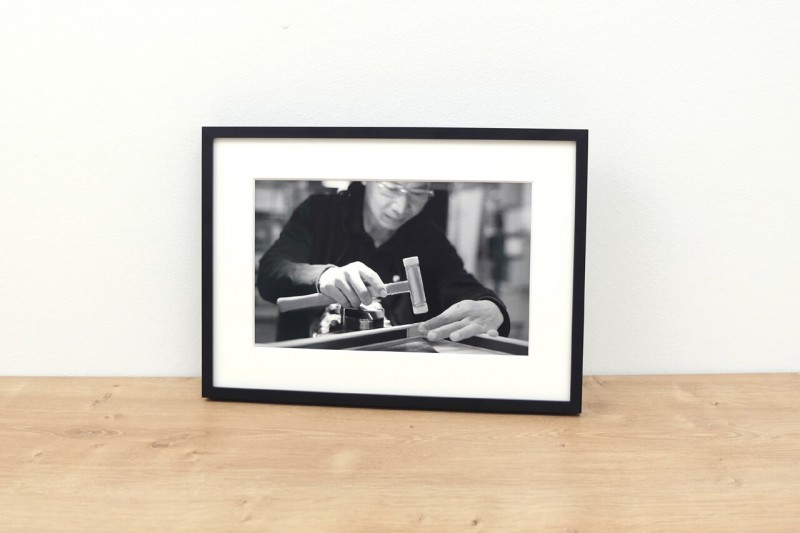
Different effects: HALBE frame without passepartout and once with passepartout
Dark motif framed in light and dark HALBE frame
The structure and colour of the paper are also important in determining the right frame.
Smooth and bright white papers also look good in finely structured aluminium. Especially when a white frame is desired, the bright white aluminium frame is best suited.
Structured, cream-coloured to wavy papers look great in lively structured wood. Here the slightly cream-coloured maple white is suitable. The structure of the paper is reflected in the wood and the broken colours let the yellowish paper shine.

The colors of the motif determine the possible colors of the picture frame, because the colors must harmonize with each other. The frame has a particularly beautiful effect when a dominant colour from a drawing or print is picked up again. This can also be the white of the paper. Black picture frames are an excellent choice for black and white pictures, but white frames also look very stylish here, depending on which colour shade predominates.


Black frame picks up black motif; silver frame picks up light grey motif
There are two approaches for the color selection of the distance strips. On the one hand you "extend" the frame inwards, i.e. you adapt the spacers to the frame colour. Or you "pull up" the cardboard to the outside, i.e. you choose spacer strips to match the cardboard colour. For example: a black frame is combined with black strips or a white background cardboard is combined with white strips.
Tip
If in doubt, choose distance strips in the color of the background cardboard, especially if there is no color matching the frame.

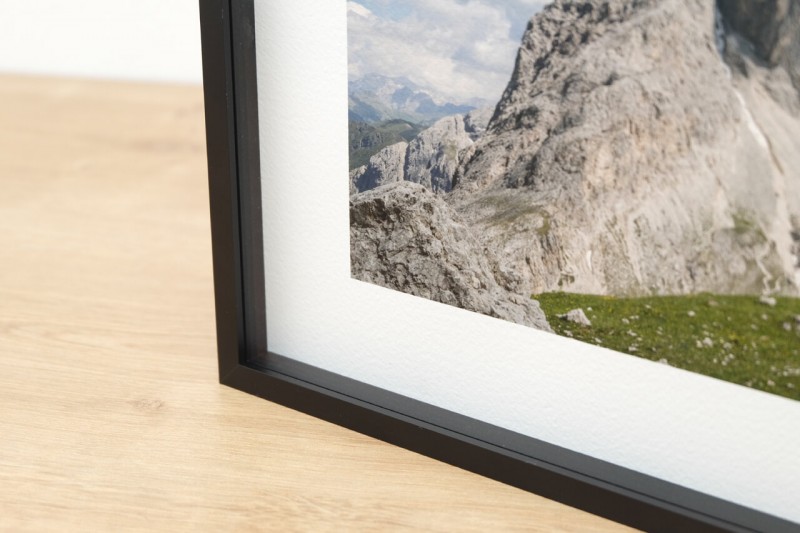
Distance strips in white, suitable for background cardboard and distance strips in black, suitable for frame
If you are still hesitant about your choice of colour, want to use the frame for changing motifs or want to create a neutral, uniform line, choose aluminium in matt silver. Plain silver is almost always suitable because it reflects the surrounding colours and adapts ideally to all motifs.
Colourful picture frames such as blue, green, yellow or turquoise are a creative no-go. Only with great sensitivity, perfectly matched to the series of motifs and presented in large neutral exhibition rooms do colored frames unfold their special effect.
Our profiles and strips differ primarily in width. The basic rule is: small size = small profile, large size = wide profile to maintain proportions. If you have several pictures in very different sizes, which belong together, you can either go to a medium width or combine different widths, as long as shape, material and colour remain the same.
Rounded profiles such as Alu6 and Alu12 appear softer and optically thinner. The narrow and flat Alu6 looks even more filigree due to the fine radii and the picture frame is thus particularly restrained. It is a good choice especially for small formats.
The shapes of the surroundings can also be picked up. Round shapes in furniture and in the room can be reflected in a rounded profile. Angular shapes are more in favour of angular profiles.
For frames over 1200x1400mm to 2000x3000mm, only wide profiles and strips are available for stability reasons. The deep versions in Alu18 or Holz22 are particularly suitable here. Due to the additional depth, the frame also appears plastic in large formats and provides additional stability.

The various profiles and strips can be found in our profile and colour overview in cross-section and with dimensions.
Glass also plays an important role for the picture, because it separates the picture from its surroundings and the viewer. The tasks of the picture glass are manifold and range from protection against dust and contact to UV protection. At the same time, it ideally provides an unclouded view of the picture. The aim is that the glass is best invisible when observing the picture.
Pay particular attention to the right choice of glass when the frames hang directly opposite windows. Here the finely frosted white glass often achieves the best effect.
You will find detailed information on the correct choice of picture frame glass in our knowledge section on picture glass.
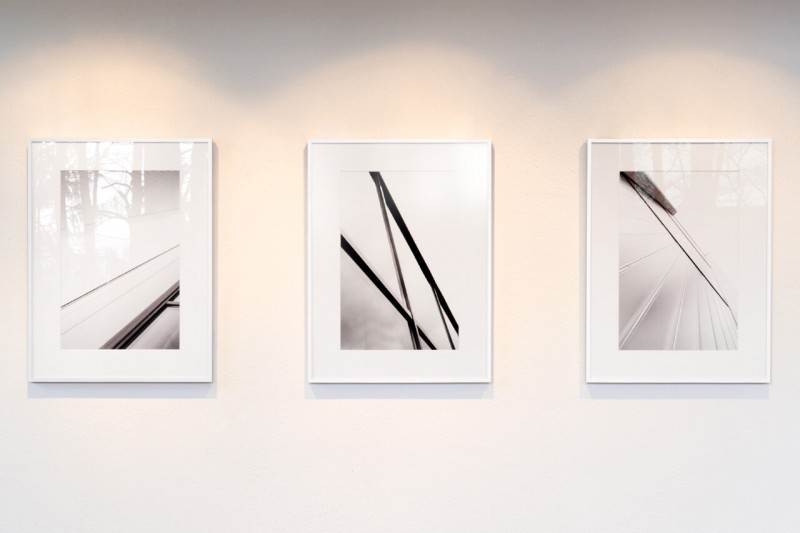
The decision on the insertion depth is less a design decision than a purely technical one. The frame must be adapted to the image on its substrate and, if necessary, to the thickness of the passepartout. The insertion depth is calculated as follows:
Image thickness + passepartout thickness = insertion depth
For instance:
1.5 mm + 3.0 mm = 4.5 mm
Standard:
0-2mm. Suitable for thin to very thick paper or common paper (e.g. 300g/m²) with 1.5mm passepartout.


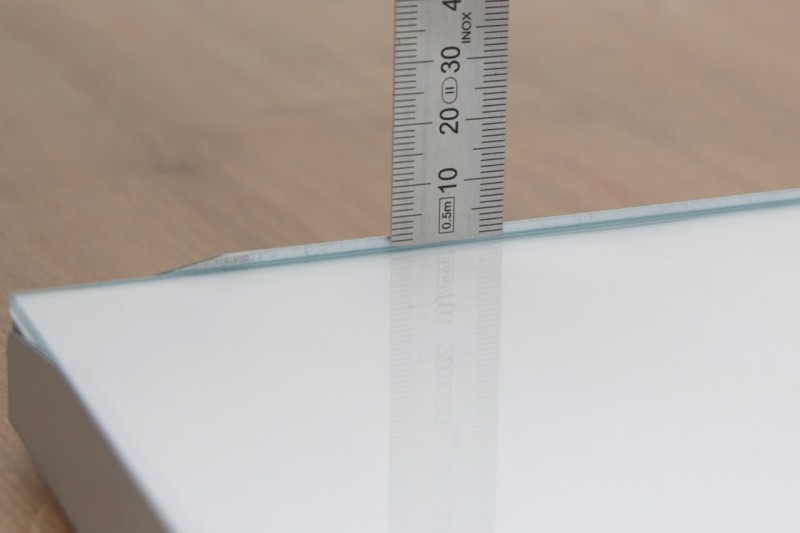
Image thickness: 0,5mm + passepartout thickness: 1,5mm = insertion depth: 0-2mm
With insertion depth:
If the inserted material is thicker than 2mm, the frame must be adjusted to the total thickness. For example for Dibonds, framing with 3mm passepartout or in folding passepartout, as well as working on a carrier cardboard. An individual insertion depth allows a tolerance of up to 25 mm.



Image thickness: 1,5mm + passepartout thickness: 3mm = insertion depth: 4,5mm
If you work through all these points bit after bit and reflect, at the end of the way there is the perfect frame for you, with which you will have a guaranteed pleasure for a long time!
Share your framing: #halbeframe














